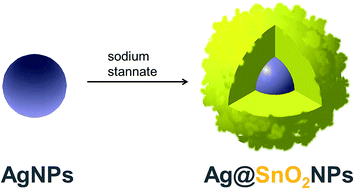Facile synthesis of SnO2 shell followed by microwave treatment for high environmental stability of Ag nanoparticles†
Abstract
This study describes a new method for passivating Ag nanoparticles (AgNPs) with SnO2 layer and their further treatment by microwave irradiation. The one-step process of SnO2 layer formation was carried out by adding sodium stannate to the boiling aqueous AgNPs solution, which resulted in the formation of core@shell Ag@SnO2 nanoparticles. The coating formation was a tunable process, making it possible to obtain an SnO2 layer thickness in the range from 2 to 13 nm. The morphology, size, zeta-potential, and optical properties of the Ag@SnO2NPs were studied. The microwave irradiation significantly improved the environmental resistance of Ag@SnO2NPs, which remained stable in different biological solutions such as NaCl at 150 mM and 0.1 M, Tris-buffered saline buffer at 0.1 M, and phosphate buffer at pH 5.6, 7.0, and 8.0. Ag@SnO2NPs after microwave irradiation were also stable at biologically relevant pH values, both highly acidic (1.4) and alkaline (13.2). Moreover, AgNPs covered with a 13 nm-thick SnO2 layer were resistant to cyanide up to 0.1 wt%. The microwave-treated SnO2 shell can facilitate the introduction of AgNPs in various solutions and extend their potential application in biological environments by protecting the metal nanostructures from dissolution and aggregation.



 Please wait while we load your content...
Please wait while we load your content...